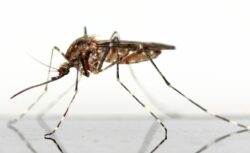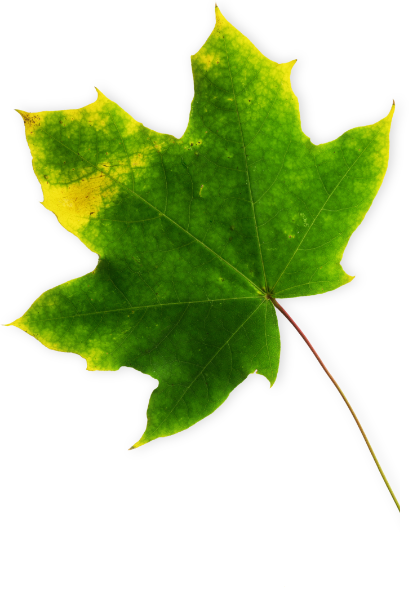Ticks & Mosquitoes
Positive West Nile Virus (WNV) mosquito samples were identified in Barnstable, Berkshire, Bristol, Essex, Franklin, Hampden, Hampshire, Middlesex, Norfolk, Plymouth, Suffolk, and Worcester Counties. During the course of this year 7 human cases of WNV were detected in in Bristol, Essex, and Middlesex Counties, according to the MA Department of Public Health. Though adult mosquitoes have died for the year, they have laid eggs that will begin the cycle in the spring. Unlike mosquitoes, ticks do not die going into the winter when temperatures drop. Ticks will continue to be active over the winter any time the temperatures are above freezing. Don’t let your guard down and continue to check yourself on those days that do warm up particularly over 40°F.
Insects
Defoliating caterpillars continue to be at low population levels where they are occurring. Winter moth caterpillars are more of a problem for smaller ornamental and fruit trees than large mature trees simply due to the comparative size difference and percentage of damage. Of the insect/pest problems I did come across this year, the vast majority seem to be from sucking type insects like aphids, adelgids and scales etc. Particularly with aphids and scale insects, sooty mold is prevalent and usually the symptom most commonly seen by homeowners when there is an insect problem. There seemed to be an increase in the numbers of hemlock woolly adelgid this season, likely due to milder than usual winter temperatures.
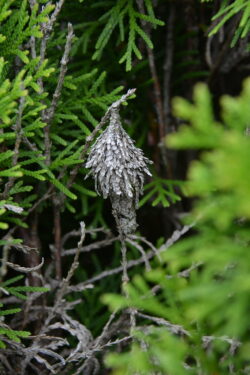 Bagworms are another insect that has been on the rise locally. Bagworms, particularly on arborvitae or juniper, do not persist well the further north you go and once was consider mainly as a pest moved annually on nursey plants from the south. Milder temperatures have allowed more bagworms to survive the winter and continue to establish on mature plantings. Bagworm larvae construct bag-like coverings over themselves with host plant leaves and twigs as they feed on plant foliage. Bagworm eggs overwinter in the bags created by the females that remain on the host plant. On small plants, hand removal of any egg-containing bags from infested host plants will help reduce the number of bagworms present on the plant next season.
Bagworms are another insect that has been on the rise locally. Bagworms, particularly on arborvitae or juniper, do not persist well the further north you go and once was consider mainly as a pest moved annually on nursey plants from the south. Milder temperatures have allowed more bagworms to survive the winter and continue to establish on mature plantings. Bagworm larvae construct bag-like coverings over themselves with host plant leaves and twigs as they feed on plant foliage. Bagworm eggs overwinter in the bags created by the females that remain on the host plant. On small plants, hand removal of any egg-containing bags from infested host plants will help reduce the number of bagworms present on the plant next season.
Emerald Ash Borer (EAB) continues to be a major contributor to decline and death of ash trees in the state. In 2021, the Massachusetts Department of Conservation and Recreation has confirmed at least 28 new community detections of EAB in Massachusetts. To date, 11 out of the 14 counties in Massachusetts have confirmed EAB. General canopy dieback and “blonding” or lighter coloration of the ash bark from woodpecker feeding are the most obvious signs of infestation. Once noticeable decline has taken place, removal is the best option, but healthy trees may be protected.
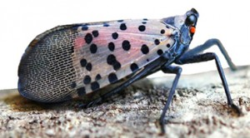 Spotted lanternfly is a new invasive insect to Massachusetts. A small, established, and breeding population was found in Fitchburg Massachusetts September 28, 2021. If any life stages of this insect are found in Massachusetts, it should be reported here: Massachusetts Outreach Project. Because the only established population of spotted lanternfly in Massachusetts is in a small area of Fitchburg, there is no need to treat outside of that area until it is found in your community. Everyone should be on the lookout for this pest since continued spread is very likely.
Spotted lanternfly is a new invasive insect to Massachusetts. A small, established, and breeding population was found in Fitchburg Massachusetts September 28, 2021. If any life stages of this insect are found in Massachusetts, it should be reported here: Massachusetts Outreach Project. Because the only established population of spotted lanternfly in Massachusetts is in a small area of Fitchburg, there is no need to treat outside of that area until it is found in your community. Everyone should be on the lookout for this pest since continued spread is very likely.
Jumping Worms
Amynthas spp. earthworms, collectively referred to as “jumping or crazy or snake” worms are an invasive species of earthworm gaining more attention. The most prominent identifying features of these worms are the characteristic quick thrashing movement and a distinct creamy white band around the body near the head. Typical European earthworms will also have a band but it is closer to the rest of the body in color. These worms overwinter as eggs in tiny, cocoons found in the soil or compost. Any remaining juvenile or adult jumping worms will die off going into the winter when soil temperatures drop. There are no chemical controls currently to manage jumping worms. A drench of mustard water however can irritate the worms and cause them to come up to the surface where they can be manually removed if found.
Diseases
If you hadn’t noticed, this past summer was particularly wet, with high frequency and amount of rain. The unseasonably wet weather resulted in lots of foliar disease on the usual disease prone plants like apple/crabapple, flowering dogwood, pear etc. We will likely see an increase in evergreen diseases for next year because of a delay in visible symptoms particularly with needle cast diseases. These are some of the diseases the Plant Diagnostic Laboratory at the University of Massachusetts Amherst saw over the season.
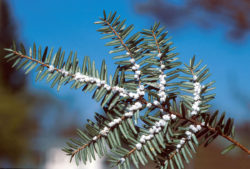 Phomopsis stem cankering on eastern hemlock. Phomopsis is the most common pathogen of eastern hemlock on samples received at the diagnostic lab. Hemlocks weakened by drought, soil compaction, restricted rooting zones, Hemlock woolly adelgid (HWA) and or elongate hemlock scale (EHS) and other landscape stresses can be susceptible to stem and branch cankering. On healthy and robust trees, Phomopsis causes only minor damage. When stressed though, symptoms of stem cankering include yellowing/browning needles, premature needle shedding, canopy thinning and branch dieback. Hemlock trees require moist, well-drained soils due to their naturally shallow root system. Restricted rooting zones, soil compaction, sandy soils and competition from surrounding trees and turfgrasses make drought stress a major contributor to decline.
Phomopsis stem cankering on eastern hemlock. Phomopsis is the most common pathogen of eastern hemlock on samples received at the diagnostic lab. Hemlocks weakened by drought, soil compaction, restricted rooting zones, Hemlock woolly adelgid (HWA) and or elongate hemlock scale (EHS) and other landscape stresses can be susceptible to stem and branch cankering. On healthy and robust trees, Phomopsis causes only minor damage. When stressed though, symptoms of stem cankering include yellowing/browning needles, premature needle shedding, canopy thinning and branch dieback. Hemlock trees require moist, well-drained soils due to their naturally shallow root system. Restricted rooting zones, soil compaction, sandy soils and competition from surrounding trees and turfgrasses make drought stress a major contributor to decline.
Branch dieback in the canopy of a swamp white oak caused by Botryosphaeria, and infestation of the obscure scale. For several years, sporadic crown dieback has been visible and submitted branch segments had clear evidence of cankering caused by Botryosphaeria. As the name would imply, this scale pest is highly camouflaged on the bark and detection can require careful examination in some cases. Scale insects can be a contributor creating the openings that the disease can enter the plant.
Beech leaf disease (BLD) is an important new disease of European and American beech trees. Unlike most other plant diseases that are caused by fungi, BLD is caused by a leaf infecting nematode (a microscopic round worm). Infection can be identified by dark banding between the leaf veins when looking up at backlit leaves. Treatment options are limited at this time, but infection for a few years can kill infected trees. This disease only adds to the more common Phytophthora bleeding cankers, and beech bark disease causing decline in beech trees.
If you have seen any symptoms on your trees and shrubs that you think are not normal, let us know. We would be happy to help identify the problem and recommend solutions to help manage your plants. You can rech out to us at (781) 297-3674 or email info@naturaltree.com.
